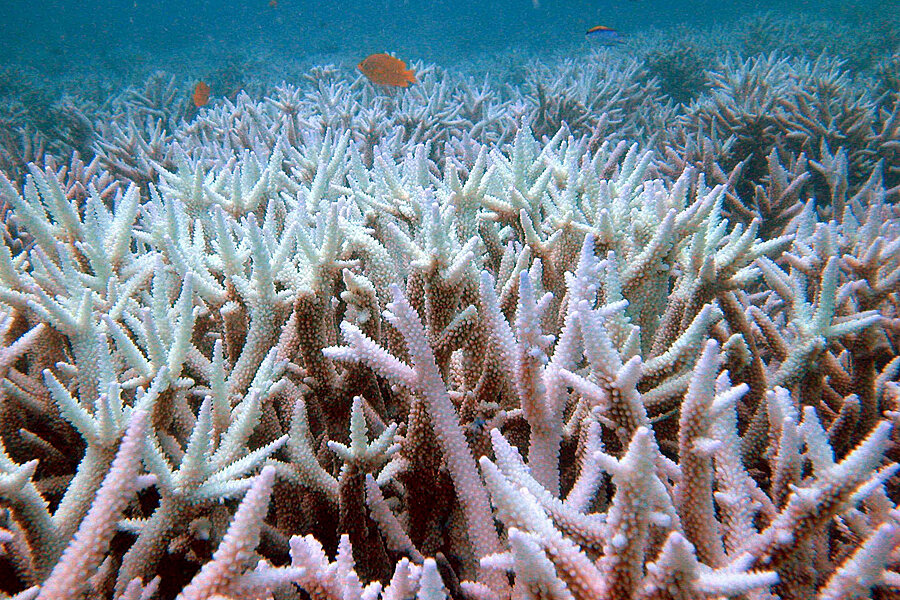Most ocean havens for fish aren't. Researchers ID ways to do better.
Loading...
The extent of the world's oceans covered by marine-conservation areas has mushroomed in the nearly eight years since President George W. Bush announced the establishment of a vast national monument embracing 140,000 square miles of ocean in and around the Northwest Hawaiian Islands.
Driving the growth, in part, is research projecting the collapse – and even extinction – of many important fish species during the 21st century, as well as studies showing that declines in marine life (both numbers and diversity) have been at least partly reversed in special marine-protected areas (MPAs).
Now, in the most comprehensive study of its kind, researchers have examined the health of 87 marine-protected areas. The bad news: In 59 percent of these conservation areas, fish populations showed little or no improvement over population estimates for areas in the same regions where fishing is unrestricted. The good news: The study team identified five factors that appear to determine a MPA's success.
These include the amount of fishing allowed within an MPA's boundaries; enforcement of an MPA's restrictions on fishing; and an MPA's age, size, and degree of isolation from heavily fished areas. The handful of most successful marine protected areas scored well on all five factors.
“It is these kinds of MPAs that we need to create and at the same time retrofit the existing MPAs that are unlikely to ever reach their conservation goals," said Graham Edgar, a researcher at the University of Tasmania's Institute for Marine and Antarctic Studies, in a prepared statement.
Decline of the world's fisheries is a longstanding concern. For instance, five months after President Bush announced the formation of the marine reserve along the Northwest Hawaiian Islands – formally known as the Papahānaumokuākea Marine National Monument – a group of marine ecologists published a study in the journal Science that painted a dim future for marine biodiversity and the ability of disturbed ecosystems to bounce back. These would undermine the ability of the sea to continue to feed humans and in many locations to help safeguard water quality.
The team found that extant trends in fishing, plus pollution and habitat destruction, could trigger the population collapse of all ocean fish currently being harvested, by the middle of the 21st century.
The team, led by marine ecologist Boris Worm at Dalhousie University in Halifax, Nova Scotia, identified marine protected areas as one of four key tools for stemming the declines. The others included managing fisheries for sustainability, reducing pollution, and safeguarding essential habitat.
Currently, some 10,280 MPAs cover 3.2 million square miles, roughly 2.3 percent of the ocean area, according to an analysis published last year by Mark Spaulding, a senior marine scientist with The Nature Conservancy, and colleagues. Coastal countries around the world have agreed to push the area covered by MPAs to 10 percent by 2020.
For its study, a team led by Dr. Edgar looked at data from 87 MPAs and gauged the effectiveness of each one by looking at the total biomass of all fish in the MPA; the biomass of large, top-of-the-food-chain fish; and the species diversity for both categories.
Averaged together, the diversity of large fish was 36 percent higher inside MPAs than in fished areas. The biomass of large fish was 35 percent higher, with the biomass of sharks in particular averaged[averaging?] 101 percent higher. But when the team calculated the species richness and biomass of all fish, the average of all MPAs appeared to be no different than the average of all fished areas. In many cases, total biomass inside MPAs was less that that of fished areas.
The team found, perhaps not surprisingly, that the ineffective MPAs were responsible for dragging down the overall performance of MPAs in fostering the recovery of biomass for all fish.
The best performers – four island MPAs run by Costa Rica, Columbia, New Zealand, and Australia – had fishing bans and strictly enforced them, covered more than 39 square miles, were 10 years old or older, and were adequately isolated from areas where fishing occurs.
Indeed, the team found that if an MPA met just two of these requirements, it did no better than fished areas. If an MPA met three or more, it did progressively better. MPAs meeting all five exhibited the most impressive conservation results. Total fish biomass was 244 percent higher, large-fish biomass was 840 percent higher, and shark biomass was nearly 2,000 percent higher than in fished areas.
Being isolated from fishing grounds appeared to be the most significant requirement. When the team picked any two requirements and added isolation, total fish biomass jumped 100 percent above that of fished areas. If an MPA met any three requirements excluding isolation, the improvement in total biomass fell to 14 percent over fished areas.
The study provides "key insights into why so many of the world's MPAs are failing to meet their full potential," writes Banjamin Halpern, a marine scientist at the University of California at Santa Barbara, in the current issue of the journal Nature, which also carries the study's results.
But it also adds a troubling element to efforts to design marine protected areas. The study suggests that the single most powerful influence on the success of an MPA is its isolation, he explains. Yet it's difficult to ensure isolation, with so many MPAs being set up along coasts because that's where they are needed.
He cites studies hinting that networks of MPAs connected by corridors that allow fish to move from one MPA to another without risk of getting hooked might make up for a lack of isolation or other factors that individual MPA managers may not be able to incorporate into their MPA designs.








